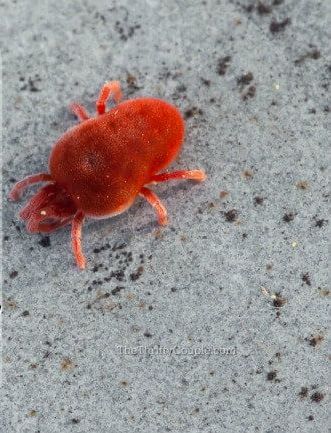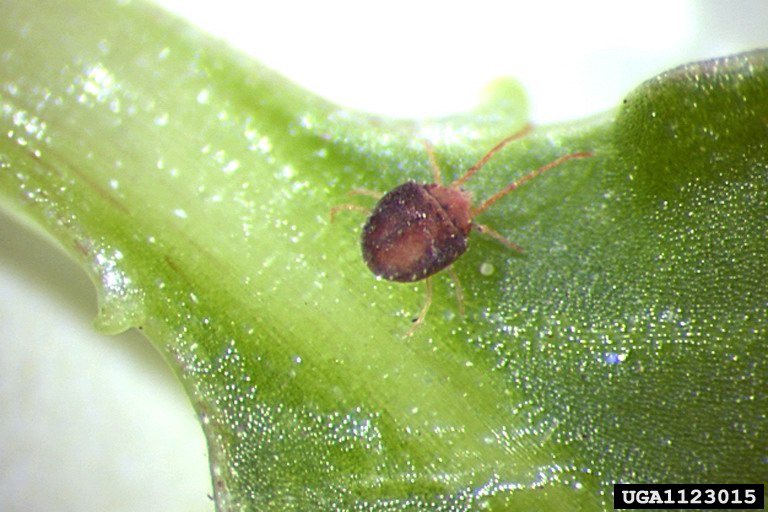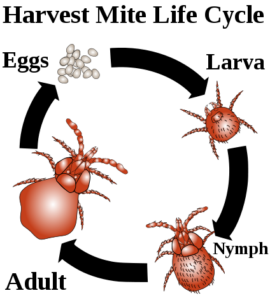I clearly prefer the growing months to the wintertime with its uncomfortably low temperatures. However, one consequence of the higher temperatures of spring and summer of which I am not enamored are the assorted creatures that enter my house. While I will get the occasional mouse, the really unwelcome visitors are insects!
Weeks ago I was sitting at my computer, minding my own business. Almost subliminally, I noticed motion on my computer screen. And yes, something very tiny and red was speeding across the screen. Using a tissue, I reached for it and suddenly there was a tiny blotch of red on the tissue. I remembered then the numerous times I had seen these selfsame dots while sitting outdoors. Brushing them away always left a red stain. Finally, I was now focused on these creatures long enough to search for an identification. It turns out that they are known as clover mites (Bryobia praetiosa Koch) and that are not even considered insects.


While insects and mites are both members of Phylum Arthropoda, insects are in Class Insecta while mites are in Class Arachnida making them only distantly related to spiders and scorpions. They are closely related, however, to ticks. Both mites and ticks are classified as members of the subclass Acari which is why the study of ticks and mites is named acarology. Our clover mite was classified in 1835/1836 by Carl Ludwig Koch (1778-1857), a German entomologist. As the first scientist to describe the organism, the name Koch is added to the usual two part scientific name.
With a name like clover mites, it is hard to understand why I am seeing them in my house. These very tiny mites ( 0.030-0.033 inches long) actually feed on over 270 species of host plants including dandelions, strawberries and alyssum in addition to clover and grasses. If garden foliage grows close to the house, the outdoor mites look for an escape from heavy rains, excessive heat or just the conditions that a change in season brings. Hence my problem. The fact that they do not reproduce indoors and will die in a few days due to dehydration is small comfort.

One of the more intriguing biological aspects of these mites is their method of reproduction. They reproduced parthenogenically, specifically thelytoky parthenogenesis. That is to say the entire population is female and the eggs that the females lay gives rise to offspring that are genetically identical to that female parent no second parent is involved. Each females will lay approximately 70 bright red, spherical eggs in the fall. These eggs will overwinter in some reasonably protected place and will hatch in the spring although they will not come out of dormancy until the ambient temperature exceeds 75° F.

The mite goes through four stages in its lifecycle by molting – larva, protonymph, deutonymph, and adult with the three earlier stages appearing much like the adult. The larval stage is bright red like the eggs and has only six legs while all the other stages all have eight legs. Two legs in the forepart of the mite are so long that they are sometimes mistaken for antennae. While the younger forms are red, the older forms darken to a reddish-brown or even further into a dark green-brown. This mite has a world-wide distribution.
A generation lasts approximately one month with the adult form living for two weeks, weather permitting. The spring generation will estivate (a form of hibernation) during the heat of the summer since they cannot tolerate very high temperatures and will complete their life cycle once the temperatures cool down. A fall generation will lay the eggs that will overwinter. Eggs hatch only between 70° – 85° F.
The clover mite does not bite and the reddish stain seen when the animal is squished come from pigments in the bodily fluids of the mite, not from blood. A heavy infestation of a lawn will leave brown areas that resemble winter kill. Penetration into home can be prevented by cutting back plantings and laying gravel in an 18-24” strip to keep vegetation in check and away from the house. If that does not help enough or there are commercial considerations, there are various chemical methods that can hold down the population.
Well, in the meanwhile the weather has heated up and the clover mites are gone. But not to worry, they have been replaced by others.
If you have enjoyed this blog piece, you may enjoy reading my book A Habit of Seeing: Journeys in Natural Science

Thanks, Sura. Please add my e-address to your weekly articles. I enjoyed much better online because of the adjacent pictures. I suggest links to references.